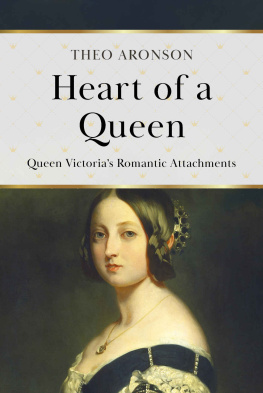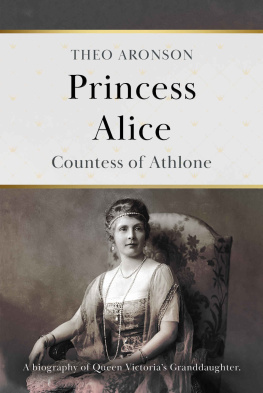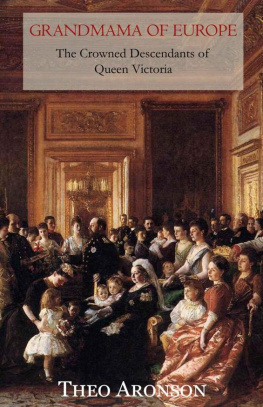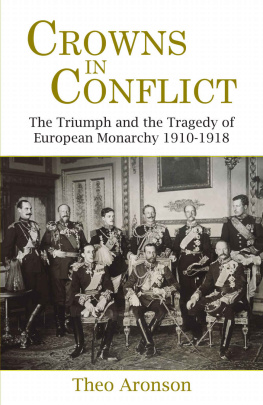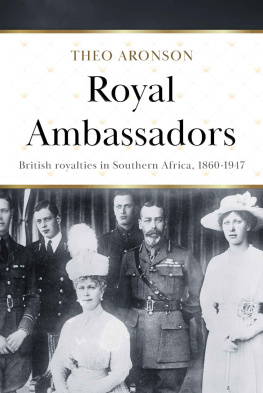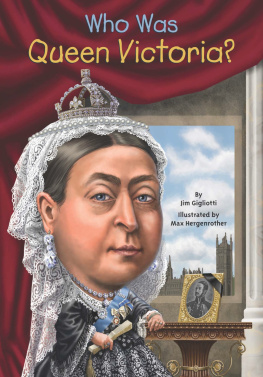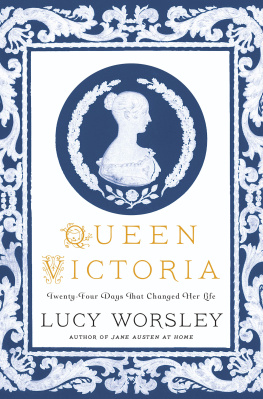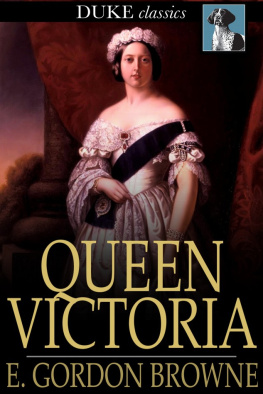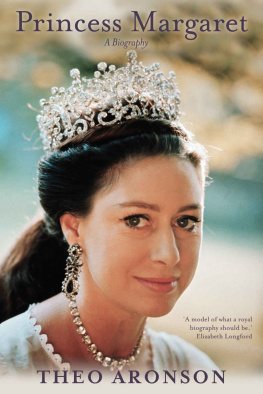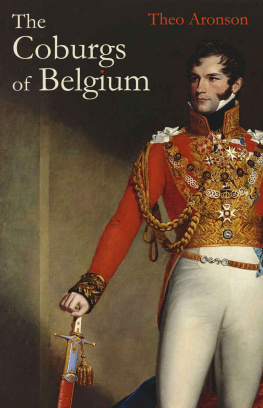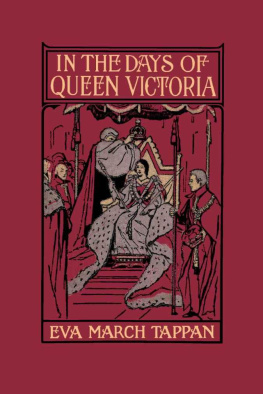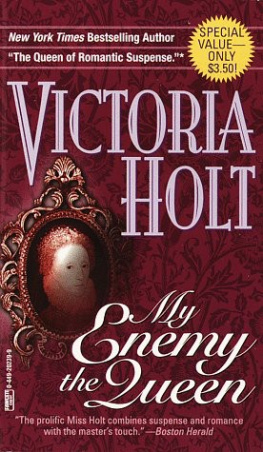Theo Aronson - Heart of a Queen: Queen Victoria’s Romantic Attachments
Here you can read online Theo Aronson - Heart of a Queen: Queen Victoria’s Romantic Attachments full text of the book (entire story) in english for free. Download pdf and epub, get meaning, cover and reviews about this ebook. year: 2021, publisher: Lume Books, genre: Non-fiction. Description of the work, (preface) as well as reviews are available. Best literature library LitArk.com created for fans of good reading and offers a wide selection of genres:
Romance novel
Science fiction
Adventure
Detective
Science
History
Home and family
Prose
Art
Politics
Computer
Non-fiction
Religion
Business
Children
Humor
Choose a favorite category and find really read worthwhile books. Enjoy immersion in the world of imagination, feel the emotions of the characters or learn something new for yourself, make an fascinating discovery.
- Book:Heart of a Queen: Queen Victoria’s Romantic Attachments
- Author:
- Publisher:Lume Books
- Genre:
- Year:2021
- Rating:5 / 5
- Favourites:Add to favourites
- Your mark:
- 100
- 1
- 2
- 3
- 4
- 5
Heart of a Queen: Queen Victoria’s Romantic Attachments: summary, description and annotation
We offer to read an annotation, description, summary or preface (depends on what the author of the book "Heart of a Queen: Queen Victoria’s Romantic Attachments" wrote himself). If you haven't found the necessary information about the book — write in the comments, we will try to find it.
Heart of a Queen: Queen Victoria’s Romantic Attachments — read online for free the complete book (whole text) full work
Below is the text of the book, divided by pages. System saving the place of the last page read, allows you to conveniently read the book "Heart of a Queen: Queen Victoria’s Romantic Attachments" online for free, without having to search again every time where you left off. Put a bookmark, and you can go to the page where you finished reading at any time.
Font size:
Interval:
Bookmark:
HEART OF A QUEEN
Queen Victorias Romantic Attachments
Theo Aronson
First published by John Murray (Publishers) Ltd in 1991
Copyright The Estate of Theo Aronson 1991
This edition published in 2021 by Lume Books
30 Great Guildford Street,
Borough, SE1 0HS
The right of Theo Aronson to be identified as the author of this work has been asserted by them in accordance with the Copyright, Design and Patents Act, 1988.
All rights reserved. No part of this publication may be reproduced, stored in a retrieval system, or transmitted in photocopying, recording or otherwise, without the prior permission of the copyright owner.
For
Gunnar Andreas Dahl
Table of Contents
Notes
Authors Note
Queen Victoria, on her own admission, had very violent feelings of affection. It is with these feelings and with the various men who inspired them that this book is concerned. It is a study of Queen Victoria in relation to the six most romantically significant men in her life; and of them in relation to her. With the Queen in her various other roles political, imperial, constitutional, matriarchal and domestic I have not concerned myself. There is no shortage of books on these aspects of her life. Nor have I dealt with the lives, public or private, of these six men, other than as these affect their association with the Queen.
Never, not even in old age, was Queen Victoria the dour, censorious puritan of popular imagination: through her complex character ran a bright thread of romanticism. Within that dumpy, uncompromising-looking figure beat a very susceptible heart. She was, and again the words are her own, naturally very passionate. That these passions were romantic rather than carnal makes them no less intense.
Queen Victorias most intimate relationships were always with men. She had no really close woman friend. The theory that her status as a queen precluded any such feminine friendship should, by rights, be equally valid when applied to men. Yet it is not. Nor were the Queens male friendships confined to men of equal, or even comparable, status. Even the Emperor Napoleon III, as the only fellow monarch to whom she was strongly attracted, was very much a parvenu. And men like John Brown and the Munshi were simply servants.
At first glance it is difficult to find any common characteristics between the various men to whom Queen Victoria was drawn between the urbane Lord Melbourne and the semi-literate Munshi, between the upright Prince Albert and the Machiavellian Napoleon III, between the brusque John Brown and the silver-tongued Disraeli. But these apparently disparate characters did have some things in common. They were all men of distinctive personality. There was nothing ordinary or banal about any of them. Even with personalities like Prince Albert and John Brown, there was something exceptional, something outr . And they all and this was probably their greatest appeal in the eyes of Queen Victoria treated her as a woman first, a queen second.
For if the heart of Queen Elizabeth I was, as she once boasted, that of a man, then Queen Victorias heart was indubitably that of a woman.
My nature is too passionate, my emotions too fervent, and I am a person who has to cling to someone in order to find peace and comfort.
Queen Victoria
Prologue
THE GIRL-QUEEN
A Girl Amid an Assemblage of Men
She entered her sitting-room in Kensington Palace, wrote the eighteen-year-old Queen Victoria of the morning that she succeeded to the throne, alone. By alone she meant that she had not allowed her possessive mother, the widowed Duchess of Kent, to accompany her into the room. Waiting for her as she entered, still in her cotton dressing gown and with her hair streaming down her back, were the Archbishop of Canterbury and the Lord Chamberlain. Falling to his knees, the Lord Chamberlain told her that her uncle, King William IV, had died four hours before, at twelve minutes past two on that morning of 20 June 1837, and that she was now Queen.
For the young Queen Victoria it was the start of a day that was to plunge her, for the first time in her strictly chaperoned life, into the company of what Disraeli afterwards described as an assemblage of men. Until that day, she had almost never been left alone with any man other than a relation or a member of her mothers household: no Boy after 7 years old was allowed to see the Child, reported one of her aunts. When, for instance, the handsome young Lord Elphinstone enchanted by the sight of Princess Victoria in a grey satin coat trimmed with roses made a surreptitious sketch of her as she sat in church, the Duchess of Kent lost no time in having him banished to India. Until the day she ascended the throne, the Princess slept in her mothers room. And now suddenly the new Queen found herself, much to her satisfaction, not only free of her mothers oppressive presence but alone, as she repeatedly emphasizes in her Journal, among a varied host of men.
During breakfast the Queen had a long talk with that Coburg family factotum, Baron Stockmar. After breakfast she received the Prime Minister, Lord Melbourne, and then saw him again at eleven. Half an hour later she held her first Privy Council in the Red Saloon at Kensington Palace. Dressed in mourning for the late King, she entered the room unaccompanied and was conducted to her throne by her royal uncles, the Dukes of Cumberland and Sussex. On being faced by this august, intimidating and sizeable body of men (there was a record attendance that day) she blushed, but soon regained her composure. Having read her Declaration in the clear and silvery voice that was to remain one of her chief attractions, the Queen presided over the swearing-in ceremony. One after another these great figures of her realm prelates, statesmen, politicians, officers of state knelt to kiss her hand.
I was not at all nervous, she afterwards wrote, and had the satisfaction of hearing that people were satisfied with what I had done and how I had done it.
The Council over, she saw her Prime Minister, Lord Melbourne, again and then granted audiences to the Home Secretary, the Master of the Horse, the Archbishop of Canterbury, Baron Stockmar and Dr James Clark whom she appointed as her personal physician. She saw Stockmar twice more that day and had a final meeting, lasting well over an hour, with Lord Melbourne.
In short, in the course of one day, Queen Victoria had been exposed, quite alone , to a greater variety of male company than she had during the first eighteen years of her life.
How did the new young Queen strike this great company of male dignitaries, many of whom were seeing her for the first time?
There was never anything like the first impression she produced, or the chorus of praise and admiration which is raised about her manner and behaviour, and certainly not without justice, raved Charles Greville, at Kensington Palace in his capacity as Clerk of the Privy Council. It was very extraordinary, and something far beyond what was looked for. She went through the whole ceremony, he said, with perfect calmness and self-possession, but at the same time with a graceful modesty and propriety particularly interesting and ingratiating .
All this was rendered more remarkable by the fact that the Queen was not particularly impressive to look at. For one thing, she was very small, not much over five foot. Nor was she a beauty; her chin was too weak, her mouth too rabbity, her hair too mousy. On the other hand, she was not without certain attractions. She had large blue eyes, a fresh complexion and that beautiful speaking voice. To these were added all the sparkle and enthusiasm of youth. Although dignified, her self-possession never became stiffness, and her composure was tempered by the most winning of blushes. The Queen might be conscientious and full of common sense but she was also an effusive, artless and affectionate girl. She was, reported one of the men attending the Privy Council, as interesting and handsome as any young lady I ever saw.
Next pageFont size:
Interval:
Bookmark:
Similar books «Heart of a Queen: Queen Victoria’s Romantic Attachments»
Look at similar books to Heart of a Queen: Queen Victoria’s Romantic Attachments. We have selected literature similar in name and meaning in the hope of providing readers with more options to find new, interesting, not yet read works.
Discussion, reviews of the book Heart of a Queen: Queen Victoria’s Romantic Attachments and just readers' own opinions. Leave your comments, write what you think about the work, its meaning or the main characters. Specify what exactly you liked and what you didn't like, and why you think so.

